8 Bird of Prey Species in Florida (With Pictures)
Last Updated on
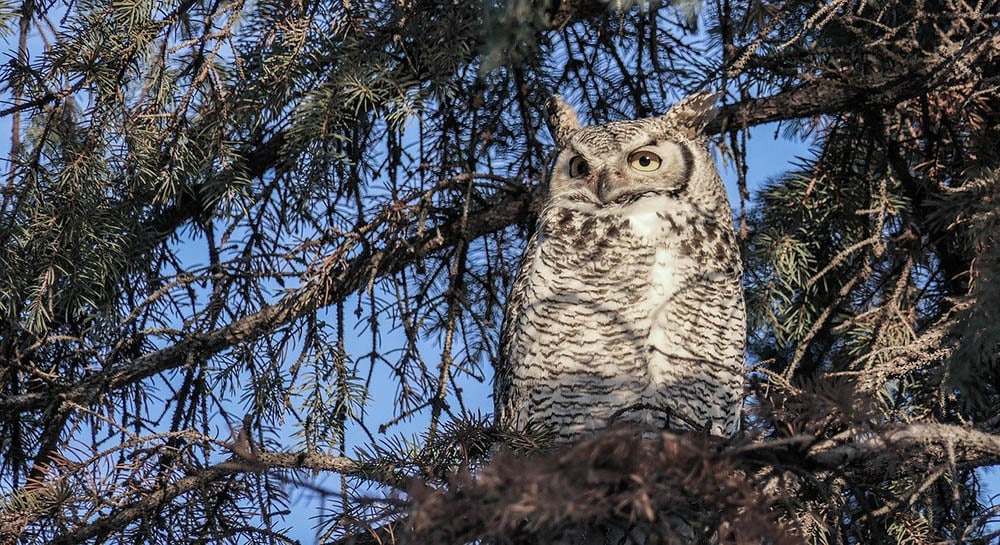
We wouldn’t go bird watching with our pets if we knew the kind of birds that we were interested in seeing were birds of prey. These species are called raptors for a reason. The word “raptor” is a derivative of the Latin word “rapio”, which loosely translates to “taking by force.”
The one thing that makes us fall more and more in love with Florida is the fact that the ecosystems are diverse. You’ll never find more of one species or less of the other. It’s almost like whoever was responsible for placing all these beautiful species in various ecosystems was striving for perfection.
But enough about that. Let’s stop wasting time and jump right into it.

Florida’s Raptor Species
1. Limpkin

| Species Name: | Aramus guarauna |
| Weight: | 2.0–2.9 lb |
| Length: | 25–29 in |
| Wingspan: | 40–42 in |
Have you ever heard of the Aramidae taxonomic family? It’s special in the sense that it only has one member – The Limpkin.
And even though this species has so many physical attributes that are akin to those of the Ibis and Heron, ornithologists say its genetic makeup indicates that its closest cousins are the cranes and rails.
Here’s another fun fact: This name “Limpkin” came about when the very first people to successfully collect its specimen thought its gait looked more like a limp than an actual gait. And to be honest, we do agree with them.
If you’re really interested in studying the Limpkin species, but don’t know where to find one, just look for an area that’s conducive for the growth and development of Apple snails. That’s their main delicacy and the reason why they love spending most of their time in ponds, marshes, and shallow swamps.
Freshwater mussels, insects, and seeds are things that they’ll only go for if they’ve realized that there are not enough Apple snails to go around for everybody.
What’s their hunting technique? A Limpkin’s hunting strategy or technique is not complicated at all. It will quietly walk into clear water and start looking for snails or mussels that aren’t aware there’s a predator around the corner.
Let’s not forget that predatory birds have incredible eyesight. So, you know it will take less than a minute to spot and grab the prey.
The males are usually more involved in selecting the nesting site. And they know what they must do, so as to ensure that their breeding season is not wasted away.
If you see them pull all kinds of vegetation around a particular spot, just know that’s the spot they’ve picked to build a nest. And it will be near some freshwater body, where the food supply is consistent and reliable.
2. The Great Horned Owl
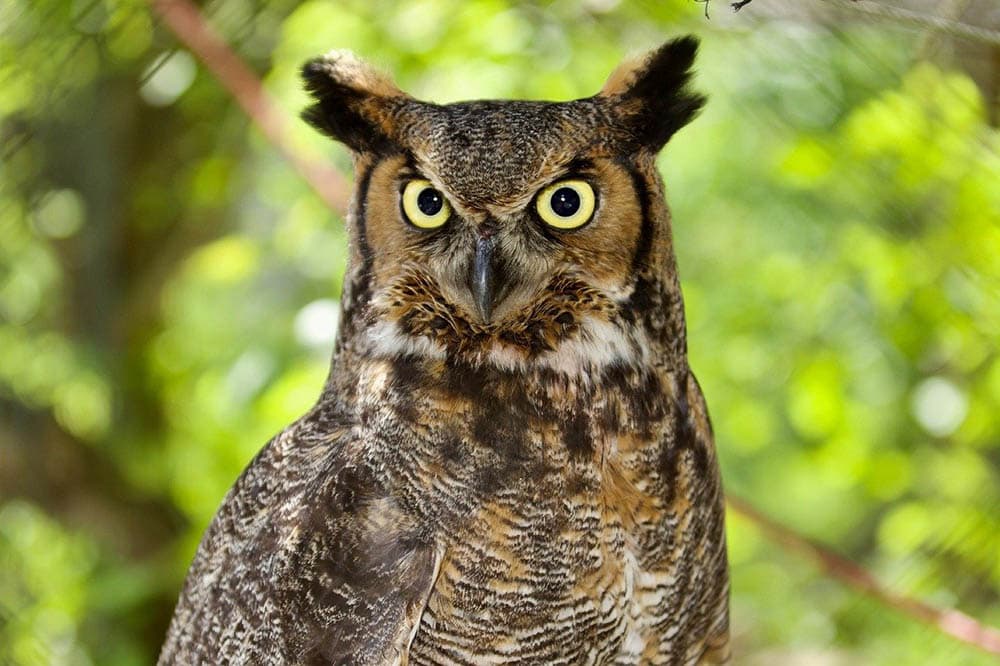
| Species Name: | Bubo virginianus |
| Weight: | 2–5 lb |
| Length: | 17–25 in |
| Wingspan: | 36–60 in |
Just a word of caution: Do not ever think about messing with the Great Horned Owl, if you love yourself and your dear life.
Don’t think about playing around its nest, don’t think about getting close to pet it, and, don’t think about trying to catch one. These birds are not only territorial but also insanely aggressive.
We know it’s easy to not be intimidated by something small like a bird, but you should be. Especially one that comes with sharp talons, that can exert a pressure of 500 psi the minute they come into contact with your skin.
What do they love eating? Meat, of course. And we’re not talking about the one that’s well seasoned or cooked. The Great Horned Owl loves to feed on mammals and birds that are unfortunate enough to share the same ecosystem with them.
If we were to describe the Great Horned Owl’s diet in one word, we would say it’s diverse. It’s diverse simply because it mostly feeds on small mammals like rabbits, chipmunks, and mice, but also snacks on insects and other raptors.
Before it slips our mind, you should know the Great Horned Owl is a nocturnal predator. They are very active at night, but sometimes go out during the day — this often happens during breeding season, when the females force the male to go hunt for food for their young ones.
3. Swallow-Tailed Kite

| Species Name: | Elanoides forficatus |
| Weight: | 0.7–1.3 lb |
| Length: | 20–27 in |
| Wingspan: | 44.4–54 in |
Nature is just amazing, and the Swallow-tailed kite is nothing more than a testament. Or how else would you describe a bird that’s literally built like a glider?
Their bodies are so streamlined, and their wings so huge, that they don’t even have to flap their wings while they are up there flying. All the other species always look like they are struggling to get a rhythm in, but the Swallow-tailed kite just does it effortlessly. Even if it feels the need to change its course, it will just make a tiny tail adjustment, and be well on its way.
Because it’s extremely maneuverable in flight, the swallow-tailed kite can catch prey in the air, without even pausing. The whole process is so swift and smooth that it’s almost too enjoyable to watch. They mostly feed on small birds, amphibians, lizards, and insects of all kinds.
An adult Swallow-tailed kite will feed on insects for the most part of the year. The only time you find them hunting snakes, lizards, and small birds is when they are nursing their nestlings. The female will lay one to three eggs every breeding season and be responsible for incubation. During that period, the male will act as the provider and the protector.
4. Black Vulture

| Species Name: | Coragyps atratus |
| Weight: | 3.5–4.9 lb |
| Length: | 22–29 in |
| Wingspan: | 52–66 in |
Even if you’ve never seen the Black vulture before, you’ll still know it’s a vulture. Their heads are just as bald as that of your typical vulture because they love feeding on carrions as well. The bald head is an adaptation that helps it mitigate risks associated with contracting different diseases.
Researchers believe that the lack of feathers around the neck and on the head is an evolution that ensures the sun’s rays are enough to disinfect that whole area, once the bird’s done feeding.
Compared to the Turkey vulture, the Black vulture is a tad bit more aggressive. In addition, it’s very selective when it comes to the food that goes into its stomach. We noticed it keeps avoiding carcasses that look extremely rotten, and our learned friends at the ornithology department found out that they are only capable of smelling carrion that is less than 24 hours old.
Oh, and did you know the species’ fecal matter is said to be 100% free of fungi, viruses, and bacteria? Apparently, the acids produced in their stomachs to help with digestion are so strong that they end up killing any form of pathogen that the bird digests.
Another fact that we found to be interesting is that the Black vulture was first classified as a Stork family, and then reclassified in 2007.
5. Short-Tailed Hawk
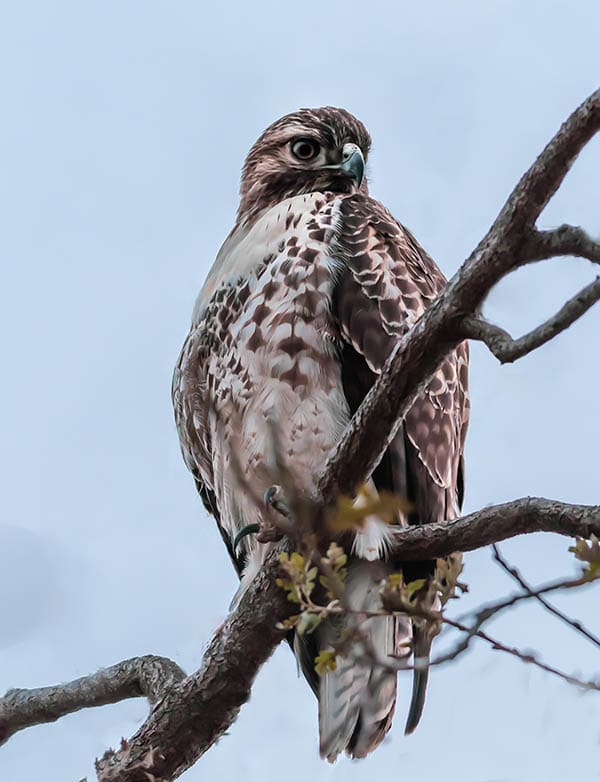
| Species Name: | Buteo brachyurus |
| Weight: | 0.9–0.97 lb |
| Length: | 15–17 in |
| Wingspan: | 32–41 in |
You should count yourself lucky if you’ve ever seen a Short-tailed hawk before. You see, although they’ve never been listed as endangered, they are very rare in the US. So rare that they can only be found in the Southern parts of Florida.
Identifying a Short-tailed hawk is not all that difficult. Depending on what stage they are in, they’ll most likely have a dark or light underside, and a striped pair of wings. Their tails are weirdly short in comparison to other members of the Buteo family, and the reason why everybody calls them “Short-tailed”.
Seeing as we’ve already brought the entire Buteo family into this conversation, we would be remiss if we decided to skate through without even talking about their dietary preferences.
We found out that the Short-tailed hawk doesn’t quite like feeding on the same things that the other members of the family feed on. It will only prey on small birds, and that’s it.
Hunting a different kind of prey is a matter of self-preservation. It will only hunt a lizard, an amphibian, snake, or large insect if it’s already gone for days without food. But they all hunt the same way — swoop down, grab the prey, carry it back to the feeding site, and then rip it into pieces before eating.
Related Read: 27 Fascinating & Fun Hawk Facts You Never Knew
6. Bald Eagle

| Species Name: | Haliaeetus Leucocephalus |
| Weight: | 10–14 lb |
| Length: | 36–43 in |
| Wingspan: | 72–96 in |
The funny thing about the Bald eagle is, they know how to hunt, but they prefer stealing food from other animals and birds. This is something that we find to be quite annoying considering it’s a species that has been blessed with features that are perfect for an apex predator.
If there’s nothing to steal, they’ll go for frogs, rabbits, gulls, and even the chickens that you like taking care of in your backyard. And they won’t stop there, as they’ve also been sighted scavenging dumpsters, and gorging carrions. It’s like everything is up for grabs with these guys.
Now, Bald eagles are not as common as they were in the 1900s. The European settlers who came here destroyed most of their habitats and killed a significant number of their breeding population. They said they had to find a way to reduce their population because they feared the birds would start feeding on their livestock.
So now whatever’s left only exists thanks to the 1940 congress that felt it was important to pass an act that made it illegal to hunt or pet the species.
Moving on, the best time to look for a Bald eagle is during summer, and not winter. They often hate the cold, as it often affects their food stores. The lakes are usually frozen and most animals like to hibernate.
7. Golden Eagle
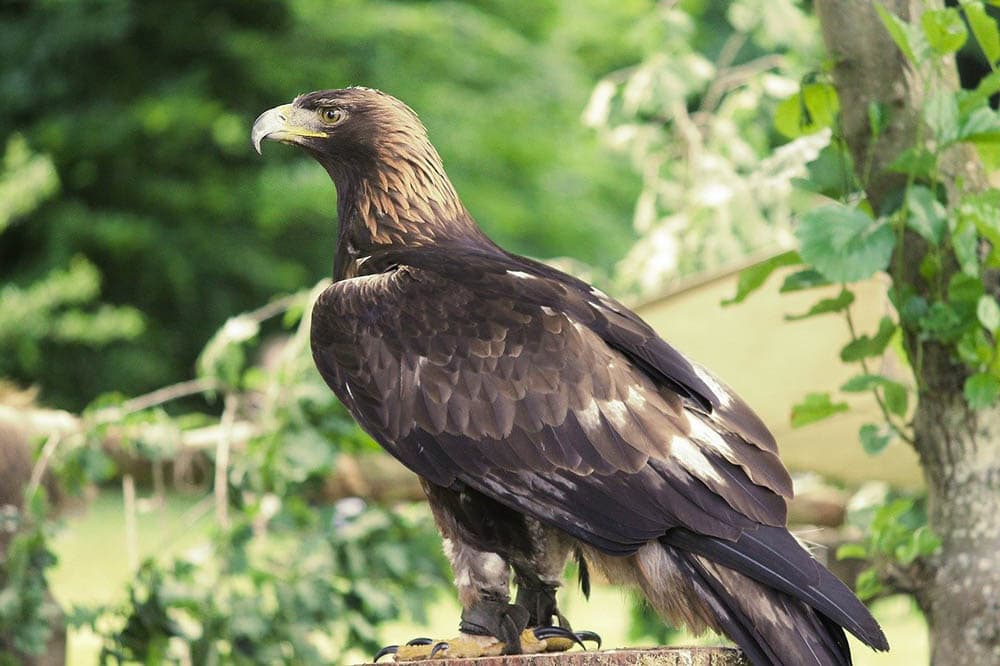
| Species Name: | Aquila Chrysaetos |
| Weight: | 7–15 lb |
| Length: | 26–40 in |
| Wingspan: | 70.9–92.1 in |
It’s okay to assume the Golden Eagle is the closest relative to the Bald eagle because it is. It might not be as recognizable as the bald-headed bird, but it’s equally amazing.
As per the data collected by our hard-working conservationists, this species is the largest raptor in North America. And what that means is, it’s a force to be reckoned with in any ecosystem.
The Golden eagle’s plumage is dark brown, with some flecks of gold around the neck region and on the head. Their bills are always yellow, and their eyes brown. You’ll never find them hovering around any human settlement, or even building homes in large stretches of forests.
Why, you ask? Well, the answer is simple. For a long time, they’ve viewed us as adversaries, so they try to avoid sharing spaces with humans. If you go out looking, you’ll find their nests comfortable sitting on riverside cliffs, or in mountainous areas.
Like every other bird of prey, the Golden Eagle is a natural hunter. And that’s why they are carnivores. Their hunting techniques are so impressive that they can easily take down a large animal such as a deer.
But, if they are not up for the challenge, they’ll settle for small mammals, snakes, frogs, fish, or even stolen prey and carrions just like their cousins the Bald eagle.
8. Peregrine Falcon
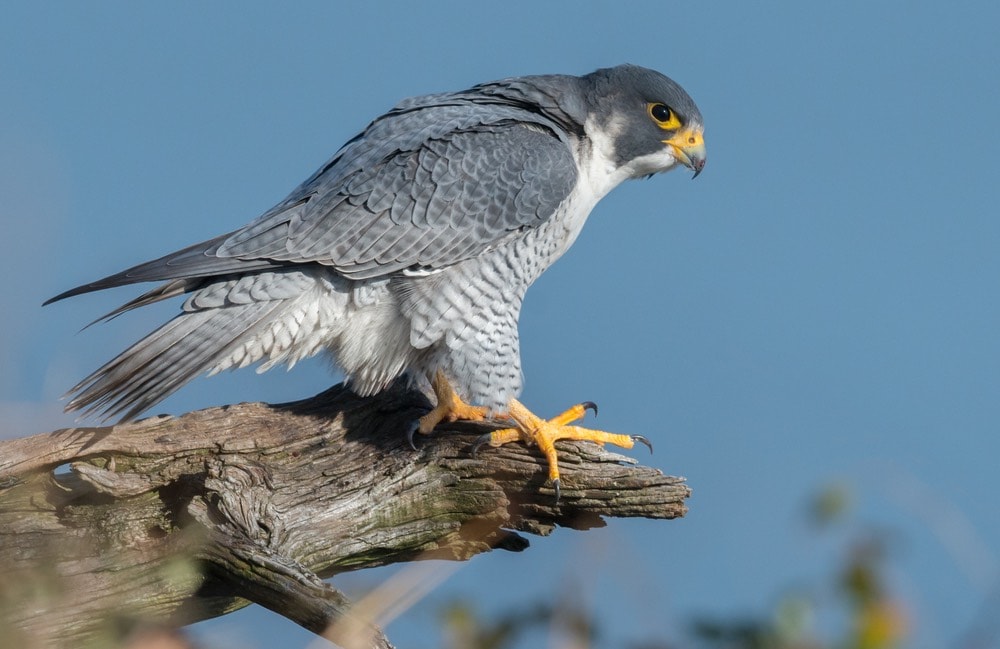
| Species Name: | Falco peregrinus |
| Weight: | 1–3.5 lb |
| Length: | 13–20 in |
| Wingspan: | 15–21 in |
Many experts believe that the Peregrine falcon is the fastest animal on the planet. Faster than a cheetah if you take into account their diving speed. When the bird is up there stalking its prey, it will slowly flap its wings and maintain enough distance to conceal its movements.
That dive, also known as the stoop, will start from 300 to 3000 feet above, and end on top of the prey. On the ground, they’ll either strike the animal using their feet — thereby killing it on the spot — or grab it before the Golden or Bald eagle shows up.
Ironically, the Peregrine falcon also has its own predators. When you see them running away from the eagle cousins, they aren’t just running to safeguard their kill. They are running to save their lives as well.
At the beginning of every breeding season, the male Peregrine falcon always makes sure he has enough nest ledges for his female mate. The females are very picky, so they won’t just lay eggs anywhere. They’ll pick a nest that they think best suits their status.
By the way, they don’t usually build nests. They’ll look for hollow spots that look a lot more comfortable than their feeding sites, and well protected.
You’ll either find them nesting along coastlines, or close to a Rock Pigeon population, that guarantees a steady supply of food.

In Conclusion
Would you say you’ve learned anything useful today? Because we’ve just gotten to the end of today’s session, and we would like to end it here, on a positive note.
We decided to write this piece because we wanted you guys to know Florida has a good representation when it comes to predatory birds. We also wanted to raise awareness and ask you to help us spread the word about our endangered species.
If you have any questions, please feel free to reach out.
Featured Image Credit: Pixabay
About the Author Robert Sparks
Robert’s obsession with all things optical started early in life, when his optician father would bring home prototypes for Robert to play with. Nowadays, Robert is dedicated to helping others find the right optics for their needs. His hobbies include astronomy, astrophysics, and model building. Originally from Newark, NJ, he resides in Santa Fe, New Mexico, where the nighttime skies are filled with glittering stars.
Related Articles:
Monocular vs Telescope: Differences Explained (With Pictures)
How to Clean a Refractor Telescope: Step-by-Step Guide
How to Clean a Telescope Eyepiece: Step-by-Step Guide
How to Clean a Rifle Scope: 8 Expert Tips
What Is a Monocular Used For? 8 Common Functions
How to Clean a Telescope Mirror: 8 Expert Tips
Brightfield vs Phase Contrast Microscopy: The Differences Explained
SkyCamHD Drone Review: Pros, Cons, FAQ, & Verdict
